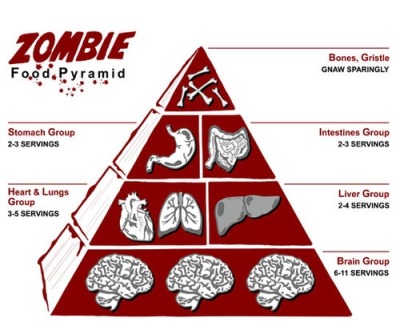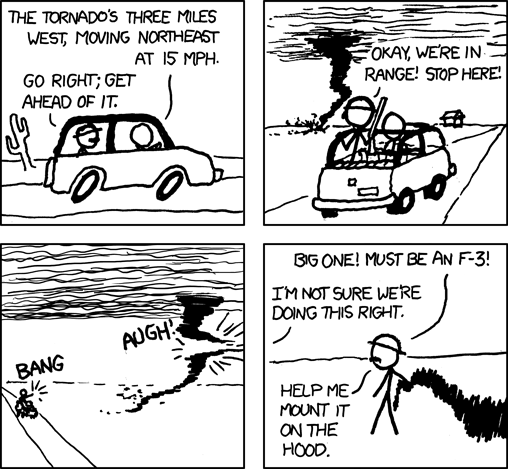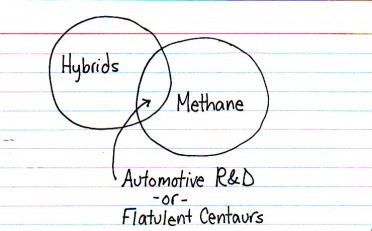Joy Division: She's Lost Control
Depeche Mode: Personal Jesus
Peter Gabriel: Sledgehammer
Is This Your Hat?
11 years ago
Miscellaneous thoughts on politics, people, math, science and other cool (if sometimes frustrating) stuff from somewhere near my favorite coffee shop.
 This is a sentiment which, as a geology person, I whole-heartedly endorse. But I was inspired to recaption; no disrespect intended, Mr. Roosevelt.
This is a sentiment which, as a geology person, I whole-heartedly endorse. But I was inspired to recaption; no disrespect intended, Mr. Roosevelt. Oh, the humanity...
Oh, the humanity...
 Stole Ohman's title, too. One of the perks of spending much of my time on the busiest street adjacent to the OSU campus, especially at the beginning of the school year, is the numerous close-call non-accidents I get to witness. Most days, the number is 2-4, and that's just during the times I'm outside smoking or chatting with friends; I'm sure the total is much higher.
Stole Ohman's title, too. One of the perks of spending much of my time on the busiest street adjacent to the OSU campus, especially at the beginning of the school year, is the numerous close-call non-accidents I get to witness. Most days, the number is 2-4, and that's just during the times I'm outside smoking or chatting with friends; I'm sure the total is much higher.Together with the metamorphic and igneous rocks of the adjacent Serie dei Laghi (SdL), collectively forming the Massiccio dei Laghi (Boriani et al., 1990), the rocks of the region record Palaeozoic accretion, metamorphic and magmatic processes, the effects of the Hercynian orogeny, post-orogenic magmatic underplating and associated lithospheric stretching and thinning, Mesozoic extension and effects associated with the position of the region in Alpine tectonism (e.g. Handy et al., 1999) (Fig.3).To the extent I have a particular interest in a specific sub-discipline of geology (I don't really), I would probably have to say igneous petrology is it. Petrology is the study of how rocks are formed; igneous petrology deals specifically with rocks that cool and crystallize from a molten state. The above implies, to me at least, that we're dealing with hot-spot volcanism. The ability to look at the compositional variations, along with temperature and pressure as recorded in minerals, from the top of the mantle to the surface of the earth is as exciting as anything I can conceive. And for those of you into structure, there are some diagrams that almost qualify as pornography (see, for example, the bottom of page 8 and top of page 9).
Geology and volcanology have seen some warranted increase in notoriety and recognition since the release of movies like Supervolcano, and since the publication of supervolcano articles in popular scientific magazines like Scientific American and Discover, however overdramatized or inexact the popular renditions might be. The Wikipedia article Supervolcano, for example, says that "Supervolcanoes are relatively new to science; they were previously unknown because they do not fit the stereotypical model of volcanoes." This statement is incorrect: very large-scale explosive caldera-forming eruptions have been known to geologists for quite some time. Hey, I knew about them way back in the dark ages, before I reached the age of thirty!I know that the enormous eruptions at Yellowstone had been well-documented by the early 80's when I started in geology, and I think it's important to keep in mind that only 15 years earlier, plate tectonic theory was only starting to be widely accepted in the US.
 Via BuzzFeed. Rogue used to be a term of condemnation. Rogue animals are often put down because they're dangerous and unpredictable. Not suggestin', just sayin'.
Via BuzzFeed. Rogue used to be a term of condemnation. Rogue animals are often put down because they're dangerous and unpredictable. Not suggestin', just sayin'.| The Daily Show With Jon Stewart | Mon - Thurs 11p / 10c | |||
| Moment of Zen - Going Rouge | ||||
| www.thedailyshow.com | ||||
| ||||
Question 1: Why is Mercury so dense?Note that most of the questions are equivalent to geology. Even though Mercury is quite close compared to the other planets, it's hard to observe because it's so close to the sun from our perspective. And though intuitively it seems that falling deeper into the gravity well should be easy, there are two issues that make it much more difficult than one might think: first, we're traveling pretty rapidly around the sun. If you want to fall inward, you have to slow your orbital velocity dramatically. Second, on the fall inward, a tremendous amount of gravitational potential energy is converted into kinetic energy; the space craft's velocity, despite its initial decrease, is enormously increased during the fall toward the sun. So if you want to get it to orbit Mercury, you have to slow it down once again when it arrives. Simply put, it's not possible to carry enough fuel (with current technology) to pull this off without some ballistic trickery. MESSENGER has performed 5 "gravity assist" maneuvers already. The last one, today, will allow it to be captured on its next approach.
Mercury's density implies that a metal-rich core occupies at least 60% of the planet's mass, a figure twice as great as for Earth! MESSENGER will acquire compositional and mineralogical information to distinguish among the current theories for why Mercury is so dense.
Question 2: What is the geologic history of Mercury?
Before the MESSENGER mission, only 45% of the surface of Mercury had been photographed by a spacecraft! Using its full suite of instruments, MESSENGER will investigate the geologic history of Mercury in great detail, including the portions of the planet never seen by Mariner 10.
Question 3: What is the nature of Mercury's magnetic field?
Mercury has a global internal magnetic field, as does Earth, but Mars and Venus do not. By characterizing Mercury's magnetic field, MESSENGER will help answer the question of why the inner planets differ in their magnetic histories.
Question 4: What is the structure of Mercury's core?
Through a combination of measurements of Mercury's gravity field and observations by the laser altimeter, MESSENGER will determine the size of Mercury's core and verify that Mercury's outer core is molten.
Question 5: What are the unusual materials at Mercury's poles?
At Mercury's poles, some crater interiors have permanently shadowed areas that contain highly reflective material at radar wavelengths. Could this material be ice, even though Mercury is the closest planet to the Sun? MESSENGER will find out.
Question 6: What volatiles are important at Mercury?
MESSENGER will measure the composition of Mercury's thin exosphere, providing insights into the processes that are responsible for its existence.
 Gawd, I love the seasons in Oregon!
Gawd, I love the seasons in Oregon!
 This is a basaltic lava flow, very likely from Hawaii. Note that it flows easily (is quite fluid); you can tell because it's thin, flat, and unbroken. Is this a "supervolcano?" Not in the public perception, though it is, as far as I know, the largest active volcanic edifice on the planet. Does it have any relevance (other than being a volcano) to the Permian volcano in Italy? Not that I know of. Why is it included? My guess is that it's a reassuring, stereotypical picture of "lava" in the journalistic mind. Story about volcanoes? Find a picture of runny, red lava.
This is a basaltic lava flow, very likely from Hawaii. Note that it flows easily (is quite fluid); you can tell because it's thin, flat, and unbroken. Is this a "supervolcano?" Not in the public perception, though it is, as far as I know, the largest active volcanic edifice on the planet. Does it have any relevance (other than being a volcano) to the Permian volcano in Italy? Not that I know of. Why is it included? My guess is that it's a reassuring, stereotypical picture of "lava" in the journalistic mind. Story about volcanoes? Find a picture of runny, red lava. This is the Yellowstone Caldera. What is the relevance? Both this and the Italian volcanoes are calderas. Yellowstone is the volcano for which I believe the term "supervolcano" was coined for some disaster infotainment show some years back. The term has no defined usage in the geological community, but if the Italian Volcano is a supervolcano, then obviously we have to haul in Yellowstone.
This is the Yellowstone Caldera. What is the relevance? Both this and the Italian volcanoes are calderas. Yellowstone is the volcano for which I believe the term "supervolcano" was coined for some disaster infotainment show some years back. The term has no defined usage in the geological community, but if the Italian Volcano is a supervolcano, then obviously we have to haul in Yellowstone. This is the Bishop Tuff. Its relevance is that it erupted from Long Valley Caldera in east central California, the second largest identified caldera in the US (after Yellowstone). We wouldn't want the public to think Yellowstone was the only supervolcano (other than the Italian example, of course).
This is the Bishop Tuff. Its relevance is that it erupted from Long Valley Caldera in east central California, the second largest identified caldera in the US (after Yellowstone). We wouldn't want the public to think Yellowstone was the only supervolcano (other than the Italian example, of course). Yes, that's right: overdraw by $7.00, and they'll charge you $363 for it.
Yes, that's right: overdraw by $7.00, and they'll charge you $363 for it. Saturday Bulletin
Saturday Bulletin Darius Whiteplume's Tumblr
Darius Whiteplume's Tumblr Skull Swap
Skull Swap

 Via Library Grape; I don't remember which blog/website Destonio's art appears on, but I'll tack it on later.
Via Library Grape; I don't remember which blog/website Destonio's art appears on, but I'll tack it on later. That Will Buff Out
That Will Buff Out There's something about this that makes me want to laugh and scream simultaneously... Picture is Unrelated
There's something about this that makes me want to laugh and scream simultaneously... Picture is Unrelated epic4chan
epic4chan I Hate My Parents
I Hate My Parents Where The Wild Things Are, By Vincent Van Gogh; Super Punch
Where The Wild Things Are, By Vincent Van Gogh; Super Punch
 Darius Whiteplume's Tumbler
Darius Whiteplume's Tumbler XKCD
XKCD Williamsburg
Williamsburg Skull Swap
Skull Swap Criggo
Criggo
 Indexed
Indexed The internet is really cheap, but then they nail you on the refills... Skull Swap.
The internet is really cheap, but then they nail you on the refills... Skull Swap. Happy Jihad's House of Pancakes, where there are a number of other blasphemous Jeebus pictures (some NSFW).
Happy Jihad's House of Pancakes, where there are a number of other blasphemous Jeebus pictures (some NSFW). XKCD
XKCD Probably Bad News
Probably Bad News
 My First Dictionary
My First Dictionary Seen at OregonLive along with the following:
Seen at OregonLive along with the following:

 epic4chan
epic4chan Skull Swap (Click to embiggen if you can't read the sign on the door)
Skull Swap (Click to embiggen if you can't read the sign on the door)

 epic4chan
epic4chan Criggo- Sorry Dad!
Criggo- Sorry Dad! From today's Sunday Sweets at Cake Wrecks. (Sunday Sweets is a regular feature with amazingly and awesomely well-done cakes)
From today's Sunday Sweets at Cake Wrecks. (Sunday Sweets is a regular feature with amazingly and awesomely well-done cakes)

